Abstract
Chalcogenide glasses are increasingly being developed for photonic applications, particularly in the field of mid-infrared optical imaging. In this paper, we study the photosensitivity of one chalcogenide to direct femtosecond laser writing and its possible applications to micro-optics. Particular attention has been paid to the creation of phase changes and related refractive index variations. This chalcogenide glass was compared with two commercial heavy oxide glasses: Schott SF10 and Corning 9754. We observed different types of permanent modifications depending on the writing speed and the laser pulse energy. Index variations were measured at in the chalcogenide glass while maintaining spectral transmission similar to the pristine materials before irradiation. This provides a good candidate to design optical components for infrared application and helps to unlock the potential of the femtosecond laser direct writing technique to implement at high writing speed and high index changes with low optical losses.
1. Introduction
Direct laser writing consists in focusing a high-intensity laser inside a crystalline or an amorphous material in order to locally modify its physical properties [1]. Since their development about thirty years ago, femtosecond lasers have been used in particular for this laser writing technique. Thanks to ultra-short pulses, these lasers can reach intensities higher than TW/cm² at the focal point. With non-linear absorption of the material due to these high intensities, the material is permanently modified in a confined volume of a few µm3. This direct femtosecond laser writing (FLDW) is therefore of great interest for its numerous writing possibilities, as well as for a number of accessible materials, especially in the fabrication of complex 3D photonic components. Indeed, current advanced femtosecond laser systems offer a myriad of material interactions in glassy media: nanocrystals precipitation [2], metallic nanoparticles precipitation and shaping [3], nanogratings formation [4], or 3D refractive index changes profiling (based on nanoscale structural changes) [1]. These materials’ interactions depend on both the laser parameters and the material chemical composition. The FLDW technique is especially studied for the creation of nanogratings and optical waveguides [5] but attracts the attention of researchers in many different fields such as diffractive and polarization optics but also gradient index optics [6] and geometric phase optics [7].
This technique has been extensively studied in silica in order to fabricate new integrated optical components: waveguides, lenses, birefringent optics, etc. However, these studies are mainly limited to visible and near-infrared wavelengths [1,8,9]. Today, the studies of the FLDW technique are growing in materials such as silicon performing in infrared [10]. Indeed, the development of integrated optical components in infrared has many attractive civilian (home automation, smartphones, automotive, etc.) and military applications.
The materials that can be used at mid-wavelength infrared (MWIR: 3–5 µm) and long-wavelength infrared (LWIR: 8–12 µm), besides silicon, are non-silicate glasses such as chalcogenides [11], fluorides [12], and heavy oxide glasses [13]. In particular, chalcogenide materials have a very wide transmission band from visible to LWIR (8–14 µm). Despite their growing use in the field of infrared optical imaging for their optical qualities, studies of their utilization with fs-laser writing are mainly limited to the fabrication of mid-IR waveguides for space applications [5,12]. The use of the FLDW technique to fabricate complex optical components embedded in these infrared materials is a fairly new and developing area [5,14].
In order to open the door to the fast prototyping of complex 3D optics (geometric phase lens, gradient index optics, etc.) for infrared applications, our study seeks to understand the modifications implemented in a set of well-chosen glasses as a function of the writing parameters (laser pulse duration, pulse energy, writing speed, etc.). We are particularly interested in the quantification of both phase and refractive index modifications, which would allow the 3D inscription of freeform objects that are more and more developed in optical imaging [15]. According to the literature, chalcogenide glasses can reach very high index contrasts: higher than [16], while heavy oxides reach lower values of a few [13], but they have better thermal and mechanical stability. Besides chalcogenides, heavy oxide glasses transmit only up to MWIR, but they are chemically stable, manufacturable by conventional means (melt-quenching), and mechanically resistant. In this paper, we study the photosensitivity of one chalcogenide glass: 75(GeS2)-15(In2S3)-10(CsCl), also named GeS2. Two commercial heavy oxide glasses are also studied: Schott SF10 (a lead oxide silicate) and Corning 9754 (a calcium alumino-germanate glass), named, respectively, SF10 and 9754 in the following. Here, we compare the main optical performances under FLDW: types of modifications, thresholds of appearance according to laser energy and writing speed, refractive index variations, and photo-induced spectral losses.
2. Materials and Methods
The three glasses studied here are divided into 2 categories. On the one hand, the heavy oxides have a rather low refractive index, and their transmission range does not go further than . On the other hand, the chalcogenide has a refractive index higher than 2 (see Table 1) and its transparency extends up to 11.5 µm. In order to spatially control the laser writing process, the samples (polished on both sides) are placed on a computer-controlled platform with three translation axes. We use the commercial Satsuma laser (Amplitude Systèmes, Pessac, France) whose amplifier is a Yb-doped fiber. In this paper, the following laser parameters are fixed: an 800 fs pulse duration, a 1030 nm central wavelength, and a repetition rate fixed at 100 kHz. An aspherical lens with a 0.6 numerical aperture allows us to focus the laser beam at 500 µm below the substrate surface. The focused beam spot can be calculated as follows:
with as the central wavelength of the laser, as the beam quality factor, and as the numerical aperture of our microscope objective.

Table 1.
Label and refractive index of the samples. The data for the 9754 and the SF10 come from the Corning and Schott datasheets, respectively. For GeS2 data were measured using refractometry in total internal reflection mode.
The scanning speed of the sample (thanks to the scanning platform) and the laser energy are variable. In order to inscribe more complex shapes than simple waveguides and more oriented towards optics or micro-optics, we write discs with a diameter of 100 µm. To write homogeneous discs, the displacement of the sample follows a spiral trajectory with a step of 1 µm. The writing speed varies from 0.01 mm/s to 25 mm/s, which corresponds to a pulse density ranging from down to . The laser energy from 0.01 µJ to 2 µJ and the polarization was kept linear and oriented along X-axis (that is define by the laser compressor plane).
3. Results and Discussion
Determination of the optical modifications landscape in the energy–speed domain: During laser direct writing, the non-linear absorption of laser energy by the material locally modifies its physical properties. Different types of permanent modifications can then appear according to the defined parameters. Three main types of modifications are defined in the literature [1,10,17]. Type I is defined as the appearance of a smooth, homogeneous, and permanent variation in the refractive index. The threshold for the appearance of the Type I change is at low energy. This type of modification allows 3D engineering of the index profiles with fine control of the refractive index variation. It is therefore a type of modification particularly interesting for the manufacture of optical components, especially in the field of imaging or for optical waveguides and gratings. Type II corresponds to an anisotropic modification of the refractive index whose orientation can be controlled by the writing laser polarization. In most oxide glasses, and according to specific conditions of pulse duration, repetition rate, pulse number and pulse energy, and self-assembled periodic nanostructures can appear and make the glass locally birefringent. With higher laser intensities, voids resulting from micro-explosions can appear in the material: this is the Type III modification. We can finally define the last type of modification appearing at high laser intensities. Often abusively called “heat accumulation regime” in the literature, this modification corresponds to a smooth and homogeneous variation of the refractive index with a significant increase in the size of the modified area compared to the size of the energy source. This spatially broadened Type I modification will therefore be referred to as the “spatial broadening regime” that described this phenomenon more accurately [18].
After the 2D micro-writing of the samples, we made an initial observation with an Olympus BX51 polarized optical microscope in order to determine the thresholds of appearance of the different types of modification. In the following, Type I is defined as a permanent refractive index contrast seen in natural light but not in crossed polarizers and whose size remains limited to the laser beam waist. In contrast, the spatial broadening regime is not necessarily a new type of modification because it is also detected as an isotropic refractive index contrast observed through optical microscopy (so in that sense it is quite similar to Type I). However, its threshold was defined here by an increase of 20% in the imprinted laser track width beyond the beam waist. Type II is detected under polarized optical microscopy and is characterized by the formation of a linear birefringence whose orientation is almost linearly dependent on the laser polarization.
Figure 1 shows the different types obtained as a function of the scanning speed and the laser pulse energy in 9754 and GeS2 glasses. SF10 has writing-type threshold graphs similar to those of 9754 in Figure 1. In particular, the energy thresholds needed for the appearance of Type I or spatial broadening regimes are similar: about 0.1 µJ for Type I and between 1.5 µJ and 2 µJ for the “spatial broadening regime”. It should be noted, however, that 9754 is the only one, which shows the appearance of Type II, and none of the three materials showed Type III—voids formation. For a low writing speed (typ. 0.01 mm/s) self-assembled periodic nanostructures appear in 9754 glass, creating a birefringence whose neutral axes are oriented by the femtosecond laser polarization [19]. In contrast, we note that the chalcogenide glass has low Type I thresholds of a few nJ at low scanning speeds and a few 10 s nJ at high scanning speeds (>1, up to ). The spatial broadening regime also appears for low energies of a few . On the contrary, SF10 and 9754 oxide glasses show thresholds of about one order higher for both Type I threshold and spatial broadening regime. Taking into account the size of the laser beam, we can express the Type I thresholds in terms of fluence (J/cm²). In our typical writing conditions, at the scanning speed of 1 mm/s, we calculate the corresponding fluence per pulse in GeS2 at 2.7 J/cm², in 9754 at 11.1 J/cm², and in SF10 at 13.3 J/cm².

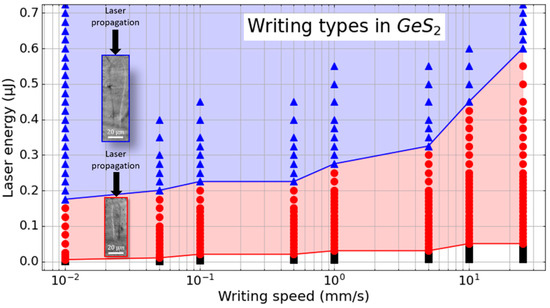
Figure 1.
On the top, processing windows in the Corning 9754. In the middle, processing windows in the Schott SF10. On the bottom, processing windows in the GeS2 glass. In the blue areas, images of a spatial broadening regime profiles (criterion: a 20% increase in laser track width compared to the beam waist). In the red areas, images of Type I profiles. Laser parameters: 1030 nm, 800 fs, 100 kHz, 0.6 NA, and linear polarization along X.
Moreover, the threshold of appearance of the different regimes depends on the number of pulses sometimes called the “incubation effect”. Typically, one can find a decrease by a factor of 2 for oxide glasses, e.g., from 13.3 J/cm² to 6.6 J/cm² in SF10 when decreasing the speed down to 0.01 mm/s (i.e., ). Following a similar trend in GeS2, but more pronounced, the threshold decreases progressively from 4.4 J/cm² for 5 pulses/μm (speed of 25 mm/s) to 2.7 J/cm² for 120 pulses/μm and down to 0.4 J/cm² for (0.01 mm/s). We also note that the size (longitudinal) of the modified zone increases with the energy but not with the number of pulses; on the other hand, the ∆n increases with the number of pulses. In addition, the width of the laser tracks remains quite similar within the whole Type I regime. This contrasts with the so-called spatial broadening regime where the width increases progressively with the pulse energy.
Therefore, we suggest here that Type I modifications are related to the accumulation of point defects leading to a glass network depolymerization, which favors a structural relaxation. For example, this is confirmed in GeS2 by Raman measurements indicating that the refractive index increase is associated not only to point defects generation but rather to glass densification (e.g., an increase in the population of edge-sharing tetrahedra in GeS2) [20]. Then, in agreement with the literature, the measured Type I thresholds decrease when the number of pulses increases. Indeed, using moderate focusing (0.25 NA), Schäffer et al. [21] observed “incubation effects” leading to a decrease in the damage threshold in oxide glasses when increasing the number of pulses, as observed during surface experiments [22,23]. In the latter case, it has been demonstrated [24] that the effect of incubation is twofold: (i) it modifies the absorption by the accumulation of point defects, and (ii) it introduces new possibilities of energy deposition in the glass network, e.g., in addition to electron-phonon coupling. These possibilities are based on a coupling of electrons trapped in the lattice. The increase in defect concentration is proportional to the initial defect concentration and the increment in the number of pulses and also depends on the number of atomic sites likely to be affected during this accumulation process.
Then, there is likely a second mechanism acting in the spatial broadening regime, which enlarges progressively the laser track’s width. In a simplified view, the spatial extension of the laser tracks (beyond the light beam size) is likely related to a temperature increase with the pulse energy [25]. Now, if we increase the energy of the pulses, the maximum temperature reached at the laser focal point increases but the spatial distribution of heat (defined by the Fourier’s law) remains unchanged. The maximum temperature is given by [25]:
where is the energy absorbed per unit volume, is the glass density, is the heat capacity, is the beam waist radius, and is the longitudinal laser beam size (depending on the NA, pulse duration, and non-linear effects). Thus, the increase in energy induces an increase in temperature and thus a spatial enlargement (beyond the light affected zone) of the imprinted laser track. This corresponds to the volume within which the temperature is higher than a threshold temperature (i.e., a transformation temperature), leading to glass structural relaxation and thus permanent index changes.
From that point, one could explain the decrease in the spatial broadening threshold when the writing speed decrease, which is a general trend observed in all three samples. Here, one explanation could be based on the accumulation of point defects (also called color centers) from pulse to pulse. This results in an increase in the absorption coefficient , with , either through an increase in the multiphoton absorption cross-section or even a reduction in the multiphoton process order by passing through a relay state (i.e., an electronic absorption level attributed to a point defect). Then, the resulting increase in energy absorbed per unit of volume () leads to a reduction in the spatial broadening threshold when reducing the writing speed.
Quantification of the photo-induced refractive index changes: In addition to microscopic observations, we performed a quantitative measurement of the phase variation implemented by fs-laser direct writing [26]. Using Quantitative Phase Microscopy (QPM, Iatia), we were able to measure a mapping of the localized phase (expressed in rad) compared to the pristine background. To study the photo-induced phase variations, a constant writing speed was set at 1 mm/s. This speed was chosen as a compromise in order to achieve fast laser writing while maintaining a high and constant index profile all along the spiral trajectory. Figure 2 plots the phase variation implemented in each material as a function of laser pulse energy. We notice that a strong phase variation appears at a very low energy in the GeS2 (about at 0.125 µJ). We also note that SF10 remains on a nearly constant phase variation above 0.7 µJ (). On the other hand, the 9754 glass exhibits a monotonous growing over a wide range of energies and allows reaching relatively strong phase variations (around at 1.7 µJ). All these glasses are of interest for the fabrication of 3D geometric phase optics [7]. Variations of with a precise phase distribution are sufficient to create most of the complex optics.
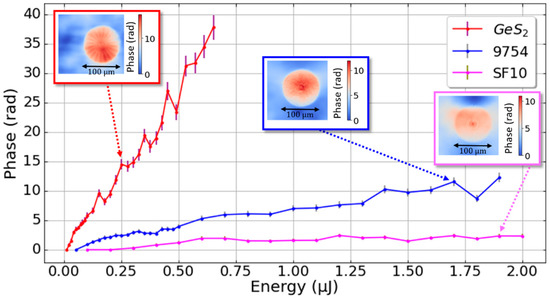
Figure 2.
Phase variation implemented by the FLDW technique as a function of laser energy. The writing speed of these irradiations is fixed at 1 mm/s (corresponding to about 120 pulses/μm). Inset: an example of a quantitative phase map measured by the Quantitative Phase Microscopy technique has been added for each material. Laser parameters: 1030 nm, 800 fs, 100 kHz, and 0.6 NA.
The FLDW technique locally changes the glass density of the glasses but also creates some point defects, which in turn affect its optical transmission [27]. Therefore, we measured the optical transmission as a function of wavelength for all samples before and after laser irradiation. In order to measure the room temperature’s optical transmission of the samples over a wide spectral band, we used two spectrophotometers: an Agilent Cary 5000 () and a Bruker Equinox 55 (). Thanks to the results presented in Figure 2 of the phase variation as a function of laser energy, we were able to implement a phase change in in our materials. We chose this variation because it is a phase shift particularly used to design Fresnel lenses, binary ring phase masks, etc.
We can observe in Figure 3 a rather important difference in transmission between the chalcogenides, transmitting up to 10–12 µm, and the heavy oxides transmitting only up to 4–5 µm. Then we notice in particular that the difference in transmission before and after femtosecond laser texturing remains quite negligible for a photo-induced phase variation of . Although it is likely that implementing a larger phase variation would imply additional optical losses in these materials, the results in Figure 3 are encouraging and bode well for a small change in the optical transmission of these glasses despite a useful magnitude of the observed changes in the refractive index.
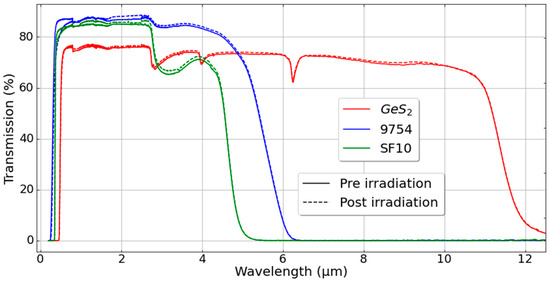
Figure 3.
Optical transmission of the studied glasses before and after a phase variation was implemented using FLDW. Laser parameters: 1030 nm, 800 fs, 100 kHz, 1 mm/s, 0.6 NA.
We have seen that we are able to implement a strong phase variation in these glasses and more particularly in GeS2 because of its binding energy, which is much lower than those of the heavy oxide glasses. The formation energy of GeS2 is about −0.66 eV/atom, whereas the formation energy of PbO (a key constituent of SF10) is about −1.47 eV/atom and −2.07 eV/atom for GeO2 and −3.41 eV/atom for Al2O3. These data are extracted from The Material Project website and calculated based on Ref [28]. For many applications, it would be necessary to convert phase variation ( in rad) into refractive index changes written by the femtosecond laser. In this view, it is sufficient to measure the thickness of the laser-modified region d to have:
where is the probe wavelength used for the quantitative phase measurement (here ). This value of is only an approximation. Indeed, it is assumed that the FLDW technique implements a constant index variation over a cylinder in the thickness of the material. In fact, the real shape of the trace depends first of all on the focusing optics, on the index, and on the non-linear index of the material. There is then a competition between the Kerr effect focusing the rays and the defocusing due to the plasma created by the fs-laser [29].
Nevertheless, we aim to use the FLDW technique to fabricate gradient index optics and geometric phase optics for infrared imaging systems. Thus, for the fabrication of graded index optics, we need to know the index variation implemented by the laser. One of the current development axes of the direct femtosecond laser writing technique is to find the materials and the laser parameters allowing one to obtain the highest possible refractive index variations. Indeed, the greater the range of index variation available, the more freedom the optical designer will have to create the optical component needed for their system. We have therefore reviewed in Figure 4 the different ranges of index variation obtained in the literature (data collected from Refs. [5,9,18,29,30,31]). Several glass families are considered, in particular mid-IR glasses: fluorides, chalcogenides, and heavy oxides, including Barium Gallo-Germanate (BGG).
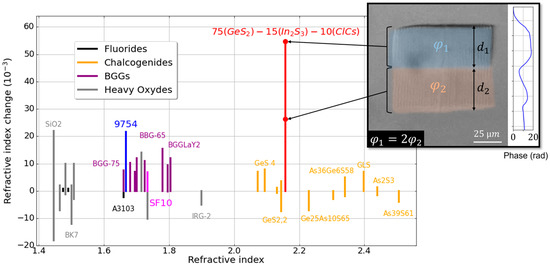
Figure 4.
Range of refractive index variation induced by fs-laser vs. refractive index (typ. Measured at 550 nm) for different glasses. Our materials: GeS2 in red, Corning 9754 in blue, and Schott SF10 in pink. Inset: a false color image of a textured disc profile showing the two sections of the phase and the associated phase profile along the cross-section.
The phase profile and the picture illustrated in Figure 4 show a distribution of the refractive index variation inside the GeS2 material that can be roughly seen as two parts of thickness, and . The upper part contributes twice as much as the lower part (, which can be deduced from the cross-section phase profile shown in the inset of Figure 4), where and , respectively, represent the phase variations in the first part and the second part of the material. Therefore, the total phase variation is . Thus, for a disc written in a single pass at high energy, we obtain two index variation sections along the z-axis, with a total thickness :
with (estimated from phase profile, see inset of Figure 4). Consequently, with a total phase variation of inside the GeS2 material (Figure 2), we obtained:
The results presented in Figure 4 confirm the good photosensitivity (i.e., at “saturation”) of chalcogenide glasses to fs-laser writing. Indeed, refractive index changes up to in GeS2 were successfully implemented. In contrast, the two heavy oxide glasses studied achieved quite large index variations for their class and in particular in the Corning 9754 glass and in the SF10 glass.
Implementation of a GRIN lens phase profile using FLDW: We are now well aware of the phase variation implemented in these materials as a function of laser energy (see Figure 2), and we can now fabricate optical components embedded in the substrate by the fs-laser writing method.
Two types of gradients, described in Figure 5, are possible in order to create the phase profile of a lens by the FLDW technique. We will call the first type a thickness gradient. For this thickness gradient, only one value of refractive index variation is chosen. The phase variation is then created by the superposition of layers of the uniform index but different diameters. It is therefore a classical lens of constant refractive index immersed in a material of constant index : . The second type of gradient is the refractive index gradient. Here, the thickness of the texturing is constant, and it is the refractive index that varies spatially. The index modified by the laser power variation during the writing process is then defined by . The phase profiles of these two types of gradients are identical but are fabricated in different ways. It will be simpler to manufacture a thickness gradient lens in that only a specific value of index variation is required. It is therefore sufficient to know the laser energy required for a single-phase variation. However, many layers are needed to manufacture a gradient thickness lens, while only one layer may be sufficient for a gradient index lens. The gradient index lens will therefore be written more quickly. For example, Figure 6 shows a diameter gradient index lens written on eight layers. The lens was written at a scanning speed of (corresponding to about 120 pulses/μm), and we can see after removing the background in the phase map that the obtained phase profile is equivalent to the designed one.
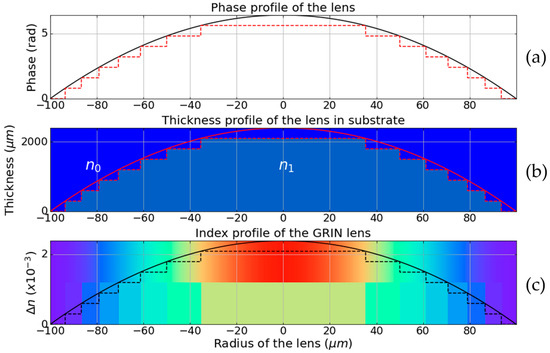
Figure 5.
(a) GRIN lens phase profile. In black, the continuous phase profile, and in red, the discrete phase profile. (b) Thickness profile of a gradient thickness lens and its discretization corresponding to the phase profile presented in (a). (c) Refractive index profile of a gradient index lens and its discretization corresponding to the phase profile presented in (a). The color variation represents the radial refractive index variation.
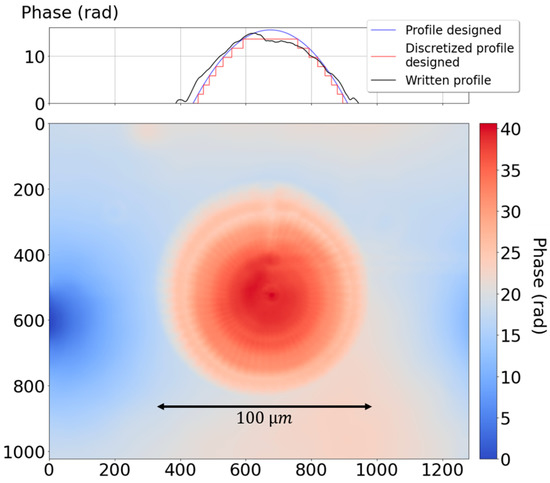
Figure 6.
Quantitative phase map of a gradient index lens written in GeS2 glass sample at scanning speed. Top: plot of the designed profile and the imprinted profile after background subtraction. Laser parameters: 1030 nm, 800 fs, 100 kHz, 0.6 NA.
4. Conclusions
In this paper, we have studied the photosensitivity of one chalcogenide and two commercial heavy oxide glasses to a femtosecond laser direct writing. We have shown the importance of this technique for writing strong refractive index or phase variations at high speed (up to 25 mm/s): up to in the SF10, in the 9754 and in the GeS2 based chalcogenide. GeS2 and Corning 9754 are particularly interesting, since they have a good potential to create optical components operating in the mid-infrared. We have obtained a good agreement between the profile of a gradient index lens written by the fs-laser in GeS2 and the expected one. The femtosecond laser direct writing technique is flexible, so we can plan to create aspherical or even freeform gradient index or complex 3D geometric phase optics, which will improve conventional optical systems. This opens the door to developing a range of efficient and compact components for infrared imaging systems and more generally 3D optics and micro-optics for IR applications.
Author Contributions
Conceptualization, M.L.; Investigation, P.D.; Methodology, M.L.; Project administration, G.D., M.L. and B.P.; Resources, L.C. and C.H.; Supervision, G.D., F.D.L.B. and M.L.; Validation, G.D. and M.L.; Writing—original draft, P.D.; Writing—review & editing, P.D., L.C., G.D., F.D.L.B., C.H. and M.L. All authors have read and agreed to the published version of the manuscript.
Funding
Agence Nationale de la Recherche (ANR-18-CE08-0004-01); FLAG-IR Project; Research supported by the Ministère des armées—Agence de l’innovation de défense (AID).
Institutional Review Board Statement
Not applicable.
Informed Consent Statement
Not applicable.
Conflicts of Interest
The authors declare no conflict of interest.
References
- Davis, K.M.; Miura, K.; Sugimoto, N.; Hirao, K. Writing Waveguides in Glass with a Femtosecond Laser. Opt. Lett. 1996, 21, 1729. [Google Scholar] [CrossRef] [PubMed]
- Fan, C.; Poumellec, B.; Lancry, M.; He, X.; Zeng, H.; Erraji-Chahid, A.; Liu, Q.; Chen, G. Three-Dimensional Photoprecipitation of Oriented LiNbO_3-like Crystals in Silica-Based Glass with Femtosecond Laser Irradiation. Opt. Lett. 2012, 37, 2955. [Google Scholar] [CrossRef] [PubMed]
- Unal, A.A.; Stalmashonak, A.; Seifert, G.; Graener, H. Ultrafast Dynamics of Silver Nanoparticle Shape Transformation Studied by Femtosecond Pulse-Pair Irradiation. Phys. Rev. B 2009, 79, 115411. [Google Scholar] [CrossRef]
- Shimotsuma, Y.; Kazansky, P.G.; Qiu, J.; Hirao, K. Self-Organized Nanogratings in Glass Irradiated by Ultrashort Light Pulses. Phys. Rev. Lett. 2003, 91, 247405. [Google Scholar] [CrossRef]
- Arriola, A.; Gross, S.; Ams, M.; Gretzinger, T.; Le Coq, D.; Wang, R.P.; Ebendorff-Heidepriem, H.; Sanghera, J.; Bayya, S.; Shaw, L.B.; et al. Mid-Infrared Astrophotonics: Study of Ultrafast Laser Induced Index Change in Compatible Materials. Opt. Mater. Express 2017, 7, 698. [Google Scholar] [CrossRef]
- Gandara-Montano, G.A.; Ivansky, A.; Savage, D.E.; Ellis, J.D.; Knox, W.H. Femtosecond Laser Writing of Freeform Gradient Index Microlenses in Hydrogel-Based Contact Lenses. Opt. Mater. Express 2015, 5, 2257. [Google Scholar] [CrossRef]
- Roux, F.S. Geometric Phase Lens. J. Opt. Soc. Am. A 2006, 23, 476. [Google Scholar] [CrossRef]
- Beresna, M.; Gecevičius, M.; Kazansky, P.G. Ultrafast Laser Direct Writing and Nanostructuring in Transparent Materials. Adv. Opt. Photonics 2014, 6, 293–339. [Google Scholar] [CrossRef]
- Eaton, S.M.; Ng, M.L.; Osellame, R.; Herman, P.R. High Refractive Index Contrast in Fused Silica Waveguides by Tightly Focused, High-Repetition Rate Femtosecond Laser. J. Non-Cryst. Solids 2011, 357, 2387–2391. [Google Scholar] [CrossRef]
- Drevinskas, R.; Beresna, M.; Gecevičius, M.; Khenkin, M.; Kazanskii, A.G.; Matulaitienė, I.; Niaura, G.; Konkov, O.I.; Terukov, E.I.; Svirko, Y.P.; et al. Giant Birefringence and Dichroism Induced by Ultrafast Laser Pulses in Hydrogenated Amorphous Silicon. Appl. Phys. Lett. 2015, 106, 171106. [Google Scholar] [CrossRef]
- Bérubé, J.P.; Messaddeq, S.H.; Bernier, M.; Skripachev, I.; Messaddeq, Y.; Vallée, R. Tailoring the Refractive Index of Ge-S Based Glass for 3D Embedded Waveguides Operating in the Mid-IR Region. Opt. Express 2014, 22, 26103. [Google Scholar] [CrossRef] [PubMed]
- Gross, S.; Jovanovic, N.; Sharp, A.; Ireland, M.; Lawrence, J.; Withford, M.J. Low Loss Mid-Infrared ZBLAN Waveguides for Future Astronomical Applications. Opt. Express 2015, 23, 7946. [Google Scholar] [CrossRef] [PubMed]
- Bérubé, J.-P.; Le Camus, A.; Messaddeq, S.H.; Petit, Y.; Messaddeq, Y.; Canioni, L.; Vallée, R. Femtosecond Laser Direct Inscription of Mid-IR Transmitting Waveguides in BGG Glasses. Opt. Mater. Express 2017, 7, 3124. [Google Scholar] [CrossRef]
- Zhou, W.; Li, R.; Li, M.; Tao, P.; Wang, X.; Dai, S.; Song, B.; Zhang, W.; Lin, C.; Shen, X.; et al. Fabrication of Microlens Array on Chalcogenide Glass by Wet Etching-Assisted Femtosecond Laser Direct Writing. Ceram. Int. 2022, 48, 18983–18988. [Google Scholar] [CrossRef]
- Lippman, D.H.; Kochan, N.S.; Yang, T.; Schmidt, G.R.; Bentley, J.L.; Moore, D.T. Freeform Gradient-Index Media: A New Frontier in Freeform Optics. Opt. Express 2021, 29, 36997. [Google Scholar] [CrossRef]
- Petit, L.; Carlie, N.; Anderson, T.; Choi, J.; Richardson, M.; Richardson, K.C. Progress on the Photoresponse of Chalcogenide Glasses and Films to Near-Infrared Femtosecond Laser Irradiation: A Review. IEEE J. Select. Top. Quantum Electron. 2008, 14, 1323–1334. [Google Scholar] [CrossRef]
- Glezer, E.N.; Milosavljevic, M.; Huang, L.; Finlay, R.J.; Her, T.-H.; Callan, J.P.; Mazur, E. Three-Dimensional Optical Storage inside Transparent Materials. Opt. Lett. 1996, 21, 2023. [Google Scholar] [CrossRef]
- Yao, H.; Zaiter, R.; Cavillon, M.; Sapaly, B.; Calzavara, F.; Delullier, P.; Cardinal, T.; Dai, Y.; Poumellec, B.; Lancry, M. Photosensitivity of Barium Germano-Gallate Glasses under Femtosecond Laser Direct Writing for Mid-IR Applications. Ceram. Int. 2021, 47, 34235–34241. [Google Scholar] [CrossRef]
- Zhang, F.; Cerkauskaite, A.; Drevinskas, R.; Kazansky, P.G.; Qiu, J. Microengineering of Optical Properties of GeO 2 Glass by Ultrafast Laser Nanostructuring. Adv. Opt. Mater. 2017, 5, 1700342. [Google Scholar] [CrossRef]
- Masselin, P.; Le Coq, D.; Cuisset, A.; Bychkov, E. Spatially Resolved Raman Analysis of Laser Induced Refractive Index Variation in Chalcogenide Glass. Opt. Mater. Express 2012, 2, 1768. [Google Scholar] [CrossRef]
- Schaffer, C.B. Interaction of Femtosecond Laser Pulses with Transparent Materials; Harvard University: Cambridge, MA, USA, 2001. [Google Scholar]
- Lenzner, M.; Krüger, J.; Kautek, W.; Krausz, F. Incubation of Laser Ablation in Fused Silica with 5-Fs Pulses. Appl. Phys. A Mater. Sci. Process. 1999, 69, 465–466. [Google Scholar] [CrossRef]
- Ashkenasi, D.; Lorenz, M.; Stoian, R.; Rosenfeld, A. Surface Damage Threshold and Structuring of Dielectrics Using Femtosecond Laser Pulses: The Role of Incubation. Appl. Surf. Sci. 1999, 150, 101–106. [Google Scholar] [CrossRef]
- Stoian, R. Investigations of the Dynamics of Material Removal in Ultrashort Pulsed Laser Ablation of Dielectrics. Ph.D. Thesis, Freien Universität Berlin, Berlin, Germany, 2000. [Google Scholar]
- Muzi, E.; Cavillon, M.; Lancry, M.; Brisset, F.; Que, R.; Pugliese, D.; Janner, D.; Poumellec, B. Towards a Rationalization of Ultrafast Laser-Induced Crystallization in Lithium Niobium Borosilicate Glasses: The Key Role of the Scanning Speed. Crystals 2021, 11, 290. [Google Scholar] [CrossRef]
- Zuo, C.; Li, J.; Sun, J.; Fan, Y.; Zhang, J.; Lu, L.; Zhang, R.; Wang, B.; Huang, L.; Chen, Q. Transport of Intensity Equation: A Tutorial. Opt. Lasers Eng. 2020, 135, 106187. [Google Scholar] [CrossRef]
- McMillen, B.; Zhang, B.; Chen, K.P.; Benayas, A.; Jaque, D. Ultrafast Laser Fabrication of Low-Loss Waveguides in Chalcogenide Glass with 0.65 DB/cm Loss. Opt. Lett. 2012, 37, 3. [Google Scholar] [CrossRef]
- Jain, A.; Hautier, G.; Ong, S.P.; Moore, C.J.; Fischer, C.C.; Persson, K.A.; Ceder, G. Formation Enthalpies by Mixing GGA and GGA + U Calculations. Phys. Rev. B 2011, 84, 045115. [Google Scholar] [CrossRef]
- Stoian, R. Volume Photoinscription of Glasses: Three-Dimensional Micro- and Nanostructuring with Ultrashort Laser Pulses. Appl. Phys. A 2020, 126, 438. [Google Scholar] [CrossRef]
- Gross, S.; Lancaster, D.G.; Ebendorff-Heidepriem, H.; Monro, T.M.; Fuerbach, A.; Withford, M.J. Femtosecond Laser Induced Structural Changes in Fluorozirconate Glass. Opt. Mater. Express 2013, 3, 574. [Google Scholar] [CrossRef]
- Messaddeq, S.H.; Bérubé, J.P.; Bernier, M.; Skripachev, I.; Vallée, R.; Messaddeq, Y. Study of the Photosensitivity of GeS Binary Glasses to 800nm Femtosecond Pulses. Opt. Express 2012, 20, 2824. [Google Scholar] [CrossRef]
Publisher’s Note: MDPI stays neutral with regard to jurisdictional claims in published maps and institutional affiliations. |
© 2022 by the authors. Licensee MDPI, Basel, Switzerland. This article is an open access article distributed under the terms and conditions of the Creative Commons Attribution (CC BY) license (https://creativecommons.org/licenses/by/4.0/).